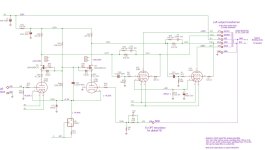It's a bit of a long story - you can read the whole thing on my website at http://www.pmillett.com/meamp2.html.
I designed an EL84 push-pull amp. It evolved from ETF.24, where a team including myself, John Bollinger, and (remotely) Douglas Piccard, and Jeremy Epstein designed and built an amp for a shootout at.
The basic circuit came from Douglas, using an ECC88 in cascode with N-channel MPSFETs as the front end. He and I had both done some designs using feedback from an ultralinear tap to the driver many years ago, and that was a starting point.
Here's the schematic, or download the whole thing as a PDF file: http://www.pmillett.com/file_downloads/meamp2_sch.pdf
The amp measures very well, around 0.02-0.03% distortion at 1W. The web page has full measurements.
I have to say that the ECC88 / MOSFET cascode diff amp is a simple but excellent front end for a push-pull amp.
Attachments
Hi Pete, I read the write-up on your site, but could not see the rationale for using the UL taps for feedback. What is the benefit? Or is it just that the experiment measured so well, that becomes the rationale?
Because it's there 🙂 and it worked well.Hi Pete, I read the write-up on your site, but could not see the rationale for using the UL taps for feedback. What is the benefit? Or is it just that the experiment measured so well, that becomes the rationale?
I think you could get the same effect by using resistor loads to both the plate and B+ to effectively get the same ratio. Though in the frequency domain using the UL taps is probably a bit different than using the entire winding due to winding capacitances, but that is just a guess.
The front end current is in opposition to the power tubes, so a bit of that effect is also in play.
Douglas
Douglas
Pete
Have you tried without global feedback, several of Douglas's E-Linear amplifiers (ST70 and 6CB5A designs) had no global feedback. Douglas's ST70 E-Linear sounded better with E-Linear feedback but without global feedback. Wondering if you had and was it better or worse (measurment and sonic). Douglas you can also give us some of your experiences.
Have you tried without global feedback, several of Douglas's E-Linear amplifiers (ST70 and 6CB5A designs) had no global feedback. Douglas's ST70 E-Linear sounded better with E-Linear feedback but without global feedback. Wondering if you had and was it better or worse (measurment and sonic). Douglas you can also give us some of your experiences.
In follow up correspondence to Walt Jung's "AudioXpress" articles on Current Sources, he was reminded that the LM317 is not a low noise device in this application. Probably not of serious consequence to this design.
- Home
- Amplifiers
- Tubes / Valves
- EL84 "Engineer's Amp" (sort of)
